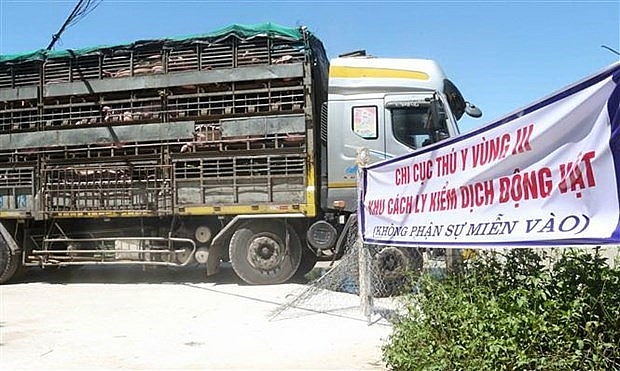Rising price of pigs yields expansion across the board
 |
| illustration photo, source: VNA |
Recent costs for live hogs (see box) in the country continued to draw a bleak picture for the domestic husbandry sector in the first half of the year. However, proactive enterprises are taking advantage of rising prices in an attempt to profit.
Reports of the vast revenue and profit of Dabaco Group JSC, a multi-field group specialising mainly in animal feed, cattle, and poultry breeding, as well as food processing, is one such example demonstrating the sector’s speed of growth.
Talking to VIR, a representative of another foreign-invested group confirmed that despite the company having to spend massive fees to prevent and control the pandemic, it still achieved its whole-year profit targets in only three months.
“This breakthrough growth has not only offset those fees but also the loss from breeding chicken. It is a historic opportunity for husbandry companies,” the representative said.
There have been no official reports about bleak business results of either foreign or domestic husbandry enterprises in the first half of this year. Even enterprises outside the sector, including steelmaker Hoa Phat Group and automobile assembly group THACO, have reported impressive business results, thanks in part to the rising price of pigs.
In 2015, Hoa Phat Thai Binh Breeding One Member Co., Ltd., a subsidiary of Hoa Phat Group, was granted an investment licence for its pig breeding project with a scale of more than 20,000 pigs in Thai Thuy district of the northern province of Thai Binh.
After five years, the group stands 17th in terms of market share in the pig breeding sector with 200,000 units in total.
In the first quarter of this year, the group earned VND480 billion ($20.8 million) in profit from its agricultural segment, accounting for 21 per cent of its total profits. Hoa Phat expects to earn VND10 trillion ($434.7 million) in revenue and VND1.2 trillion ($52.1 million) in after-tax profit from agriculture, making it the second-largest revenue stream following steel.
Group chairman Tran Dinh Long confirmed at its shareholders’ meeting in May that a large part of the profit from the agricultural segment came from the higher selling price of pigs.
Being aware of the important contribution of the husbandry sector, Hoa Phat will continue to promote existing livestock farms and expand when possible. The group’s goal is to reach a maximum capacity of 600,000 tonnes of animal feed and 450,000 pigs per year.
Last month, meanwhile, THACO added pig breeding to its business registration certificate. This move came in the context of failures in the cow breeding sector.
The expansion of enterprises has raised expectations of a bright picture for the animal husbandry sector the second half of this year, following a bumpy past six months.
Risks of a return of African swine fever (ASF) and the impact of the current pandemic have been creating difficulties for re-populating pigs and ensuring steady supply for the domestic market.
In the first six months of this year, the industry faced massive difficulties due to both disease outbreaks. The latest report published by the Ministry of Agriculture and Rural Development showed that ASF returned in 20 cities and provinces including in Hanoi, Cao Bang, Bac Kan, and Lang Son in the north, forcing a cull of 4,000 pigs.
A representative of a foreign-invested husbandry company told VIR, “While ASF has broken out again, the number of pigs raised by households remains limited, thus information about the epidemic has not been mentioned regularly in the media.”
Meanwhile, along with the impact of the pandemic, the cost of breeding pigs has been another barrier for re-populating herds.
Pig farm owner Nguyen Tan Hau told VIR that the selling price had already increased to nearly VND2.5 million ($110) per unit, and is even more so now. “I hoped the price would fall when Thai-imported breeding pigs arrived in Vietnam. However, the selling price of has climbed to VND3-3.5 million ($130-152) per unit.”
| The average selling price of pigs plunged to VND84,000 ($3.60) per kilogramme last month, to better align with the price of imports from Thailand. According to a report published by the Department of Export and Import under the Ministry of Industry and Trade, in June, the price of pigs in the local market decreased to better compete with imported pigs. In the northern region, the price stood at VND85,000-91,000 ($3.70-3.95) per kg, while in the central region it was VND84,000-88,000 ($3.65-$3.80), and VND85,000-88,000 ($3.70-3.80) the southern region. The department forecast that prices will continue to decline in the coming weeks as pig imports from Thailand increase. These imported pigs fetch around VND82,000 ($3.55) per kg. According to statistics from the Ministry of Agriculture and Rural Development’s Department of Livestock Production, as of July 5, 30 Vietnamese enterprises registered to import 4.5 million pigs from 13 Thai exporters. Seven of these businesses have imported 9,000 pigs in total. |
What the stars mean:
★ Poor ★ ★ Promising ★★★ Good ★★★★ Very good ★★★★★ Exceptional
Related Contents
Latest News
More News
- PM orders investment model for North–South high-speed rail (December 22, 2025 | 17:43)
- First members of Danang International Finance Centre revealed (December 22, 2025 | 17:39)
- Securing capital and efficiency for Vietnam’s 2026-2030 growth ambitions (December 17, 2025 | 10:00)
- Driving double-digit growth through green and circular transformation in Vietnam (December 17, 2025 | 09:00)
- Vietnam bucking trend in the global M&A landscape (December 16, 2025 | 14:20)
- Vietnam’s green transition demands collective financial action (December 15, 2025 | 12:00)
- VIR workshop highlights capital and policy for sustainable development (December 15, 2025 | 11:00)
- National Assembly approves pilot mechanisms to accelerate major projects in Hanoi (December 12, 2025 | 11:29)
- Vietnam eases policy approval requirements, simplifies foreign and outbound investments (December 11, 2025 | 17:53)
- Unpacking new momentum in Vietnam’s M&A market (December 10, 2025 | 09:59)

 Tag:
Tag:





















 Mobile Version
Mobile Version